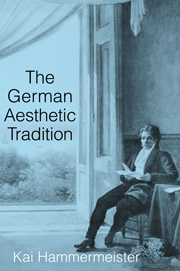1 - Baumgarten, Mendelssohn
Published online by Cambridge University Press: 14 January 2010
Summary
Alexander Baumgarten
Immanuel Kant's (1724–1804) towering presence at the end of the eighteenth century tends to throw a shadow backward in history, eclipsing many of the less forceful and original thinkers. The situation is no different in philosophical aesthetics. Although Kant's 1790 Critique of Judgment – unlike the 1781 Critique of Pure Reason that received little friendly attention until Reinhold's Briefe über die Kantische Philosophie (Letters on the Kantian philosophy) of 1786–7 – created a fanfare on the philosophical scene (some slight delay in reception notwithstanding), it did not emerge from out of the blue. Kant had already reacted against previous, albeit more modest attempts to ground a philosophical aesthetics – attempts, however, that ultimately failed to establish an aesthetic paradigm to serve as a starting point for productive elaborations or dissent for future generations.
The pre-Kantian philosophical aesthetics were not meant to be a break with the dominant philosophical system, namely, that of Leibniz and Wolff. Instead, they should be considered elaborations of it that nolens, volens helped to undermine the foundations that they labored to strengthen. When Alexander Baumgarten (1714–1762) introduced the plan for aesthetics as a new philosophical discipline with its own name, he did so in order to prop up the traditional rationalist metaphysics by making it more encompassing. Yet Baumgarten's attempt to consolidate rationalism turned, under his hands, into a critical endeavor.
- Type
- Chapter
- Information
- The German Aesthetic Tradition , pp. 3 - 20Publisher: Cambridge University PressPrint publication year: 2002

